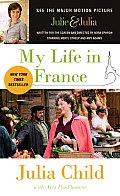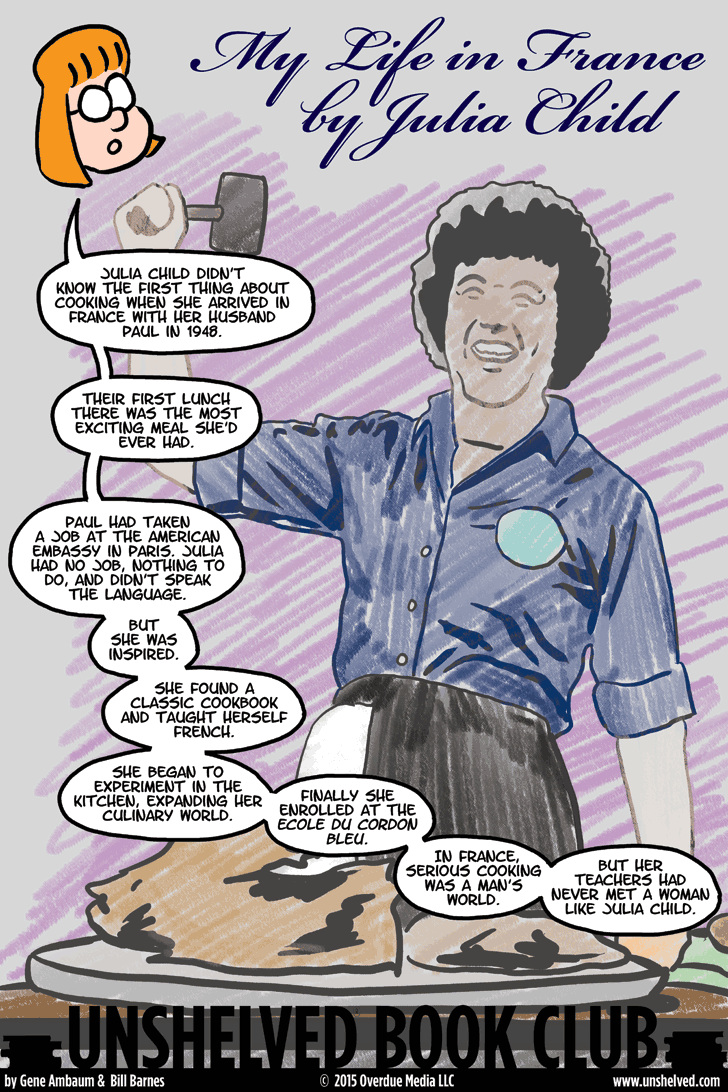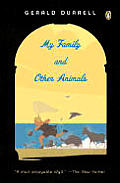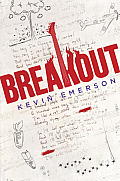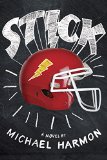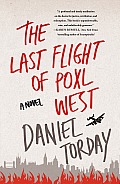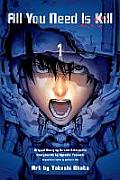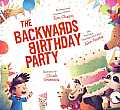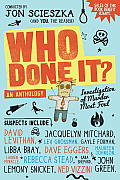Link to this review in the form of a comic strip by saracole tagged biography
Link to this review by wally tagged classic • literary
When the English weather turned much too damp and gray for the Durrell family, the eldest son Larry persuaded them all to move to the Greek island Corfu. Gerry, the youngest of the four kids, discovered a large number of animals he simply had to have, including a lovely scorpion, a pair of magpies, an owl, and a couple of huge toads. The family didn’t always approve of Gerry’s zoo, but their own idiosyncrasies clearly made them just as unusual.
Why I picked it up: I read this over thirty years ago and was reminiscing about it with my wife, who had also read it in her youth. (We both read it again.)
Why I finished it: Durrell is a natural storyteller. Between lush descriptions of Corfu’s flora and fauna, he introduces a number of memorable characters like Spiro, the Greek who spent a few years in New York, where he picked up a Brooklyn accent, and Theodore, a scientist with a load of terrible puns. Among those characters are wonderfully personified animals, too, like the sociable Roger, the family dog, and a pair of magpies that play among the manuscript pages of Larry’s novel until Gerry finally builds them an aviary. One particularly memorable chapter involves a long drama between Geronimo the gecko and Cicely the mantis as they chase each other across Gerry’s bedroom ceiling.
It’s perfect for: Laurie, who loved all of James Herriot’s books, starting with All Creatures Great and Small. She’d enjoy the humans as much as the animals, and would laugh when the family decides to throw a party for all their friends — it almost falls apart when Gerry tries to revive a couple of his pet snakes in the bathtub.
Link to this review by darcy tagged coming of age
Anthony Castillo has had it. His teachers are jerks, and his parents don’t understand him. His best friend Keenan is dating his ex-girlfriend Skye, which is okay except when it’s not. The only thing that really makes Anthony happy is when he’s playing video games and learning new tunes on his guitar for his rock band, The Rusty Soles. When the band’s lead singer gets suspended, he worries they won’t be able to perform at Fall Arts Night, so he writes and records some lyrics and sends them to Keenan. They are angry, edgy lyrics that contain the f-word. Keenan posts them online and the song is an overnight sensation. Despite his new fame, it becomes very clear that the band will not be allowed to play at a school event if their song has bad language in it.
Why I picked it up: When I learned it was about rock and roll and the f-word, I knew this was the book for me.
Why I finished it: Anthony is a realistic character who struggles with his weight and attends an exercise class he calls “fat class,” which his mother signed him up for. She’s worried about his health and diabetes so she constantly monitors his sugar consumption. Anthony’s voice is compelling, and I could really relate to his daily struggles with school and dating. Mr. Darren, the rock band teacher, supports Anthony’s choice of whether or not to use the f-word in his lyrics. I love that he calls the students by the names of famous rock musicians like Slash or Mr. Cantrell of Alice in Chains fame as terms of endearment. The other characters in the book were also a lot of fun. By the end of the novel I really felt like they were my friends.
It’s perfect for: My son, who is starting to feel the pain of adolescence. I know that he will really relate to the parts where Anthony gets in trouble with teachers, especially when one sends the dreaded Email Home. Because he has a new interest in classic rock and drumming, the descriptions of Valerie playing the drums will keep him coming back. (The few curse words won’t hurt, either.)
Link to this review by flemtastic tagged coming of age
Brett is called “Stick” by everyone around school because the football seems to stick to his hands as he runs past hapless defensive backs. When he witnesses a few teammates picking on a nerdy kid (Preston), he realizes that some of his teammates are bullies. Stick stops them and gets the players in trouble. After the football coach allows them to retaliate, Stick has had enough. He tells his overbearing dad he is done with football. No one believes him, because a scout from UCLA is coming to watch the next game, but Stick knows he means it.
Why I picked it up: I’m always looking for well-written, football-themed books for my middle-school library. I was hoping it was as good as Carl Deuker’s Payback Time, Mike Lupica’s QB 1, and Tim Tharp’s Knights of the Hill Country.
Why I finished it: Stick turns the stereotype of football players as uncaring brutes, concerned only with sports and their own popularity, on its head. He strikes up a realistic friendship with Preston, who turns out to be quite remarkable himself. And I loved the way Preston made tens of thousands of dollars off the stupidity of his bullies.
Readalikes: John Feinstein’s newest sports-related YA book, The Walk On. Both deal with high school athletes who love football, but have family or coaches getting in the way of their enjoyment of it. Each has a grittiness that kids will love, with great descriptions of long touchdown passes and bone-wrenching hits.
Link to this review by geneambaum tagged picture book
Cupcake tries to figure out what kind of birthday party she should have, but each type of party comes with its own potential problems.
Why I picked it up: I’m a fan of Border’s Bent Objects Project.
Why I finished it: The images are photographs of objects, usually with wire limbs added, and it’s amazing how much personality the right pose can give to doughnuts, melting chocolate bars, and a pet eclair. And the pictures always have funny bonuses. A floating party on a big boat would be great, but Soup might lose his lunch. (Soup is a bowl full of alphabet noodles and veggies. After he’s gotten sick, at his feet are noodle letters spelling out “sorry” and “seasick” amid peas and carrots and corn and broth, all of which Cupcake is mopping up.) When Cupcake imagines a game of musical chairs, a band called The Musical Fruit is playing — each member is a can of a different kind of beans playing an instrument. Clever.
Readalikes: Sara Varon’s Bake Sale in which Cupcake (a baker) tries to earn enough money to travel to Turkey and meet the famous chef Turkish Delight.
Link to this review by diane tagged historical fiction • literary
When he was younger, Eli listened stories his Uncle Poxl told of life in Europe before and during World War II. Poxl fled his native Czechoslovakia just ahead of the Nazis, first to Holland and finally London, leaving his family and a string of broken hearts in his wake. Poxl’s tales of life as a bomber pilot for the RAF really intrigued Eli, who loved imagining a Jewish pilot dropping bombs on Nazis to repay them for their campaign against his people.
Eli’s story is set in the present day. Since Poxl is unavailable to Eli while he gallivants around the country on a book tour, Eli maintains the connection to his uncle by reading his memoir. Eli begins to realize that the tales his uncle shared didn’t tell the whole story. Perhaps Poxl isn’t the hero Eli has always believed him to be. The book alternates chapters between Eli and Poxl, so we get to experience Poxl’s loves, losses, and triumphs during WWII as well as Eli’s reaction to them.
Why I picked it up: Because of John Green’s comment on Twitter: “POXL a lovely novel sentence-to-sentence, and it gets at something deep about how we’re all frauds, and all worthy of love.” I ordered it immediately, knowing nothing about it other than my favorite author found it moving.
Why I finished it: I started the book the day it arrived on my doorstep and finished it in three days. The voices of Eli and Poxl both felt completely real. I found Eli’s story the more moving of the two; he’s a young man who realizes that life is really just a series of choices, sometimes with unexpected consequences.
It’s perfect for: My friend, Jen, who loves historical fiction, but who really loves stories about family relationships and heartbreak that aren’t sappy or sentimental. This is the perfect combination of history, adventure, romance, and family.
Link to this review by snow tagged graphic novel • science fiction
Keiji, a new soldier, dies in his first battle against alien invaders called Mimics. Then he wakes up again on the day before that battle.
As he fights and dies and reawakens at the same moment, over and over again, Keiji becomes determined to survive and find a way out of the time loop. A tough-as-nails American soldier, Rita, nicknamed the Full Metal Bitch, also knows about the time loop, but will she save him or cause him to die for the final time?
Publisher’s Age Rating: T+/Older Teen
Why I picked it up: The plot of the movie version (Edge of Tomorrow) sounded like my kind of action-filled science fiction, but I’m not a big fan of Tom Cruise. When I saw the manga adaptation of the Japanese novel was illustrated by Takeshi Obata, illustrator of Death Note, I jumped at the chance to read it.
Why I finished it: It was indeed action-filled, which made for just the sort of fast read I wanted. I like that the focus of the story was on both the fighting and the training for fighting. Keiji’s initial reaction to battle and to being trapped in the loop is panic, but once he realizes that he isn’t getting out of either, he quickly moves onto steely determination to survive and trains with a desperate intelligence that is gripping. Rita is the same way, though her reasons for training are much different, which gives her a unique focus and keeps the story fresh when it moves to her perspective halfway through. Obata’s art is excellent, with realistic men, manga-esque women, robotic body armor, gigantic combat weapons, and terrifying aliens.
Readalikes: The Story of Owen and its sequel, Prairie Fire, by E.K. Johnston aren’t as bloody as All You Need is Kill, but they share a common theme: young people pressed into military service against an inhuman foe. Owen and Siobhan live in a modern world where dragons are an everyday menace. Most people hide, but Owen comes from a storied line of dragon slayers and must do his duty for the world with Siobhan as his bard. Like Keiji and Rita, Owen and Siobhan just want to survive, but it’s going to take training — and teamwork — to do so.
Link to this review by geneambaum tagged picture book
In this picture book based on the song of the same name from Chapin’s 1994 Zag Zig, a boy puts his clothes on inside out, heads downstairs, and says, “Good-bye!” to his friends (who are walking in backwards).
Why I picked it up: I’m still scarred by reading Philip K. Dick’s Counter-Clock World in high school, though I’m not sure what was more disturbing, the idea of libraries erasing books from existence or what happens with the digestive system when food has to run backwards through it.
Why I finished it: The animals at the party (and the rest of the drawings) all look very soft — it’s some combination of color, light, and the texture of whatever was used to draw them. This softness makes them look incredibly fun and friendly, from the hedgehog holding the “YADB” pennant to the cat with the upside down hat on his head (there’s a bird in the hat).
It’s perfect for: My nephew, Layton. He’s got a birthday coming up, and I think he’ll love that at the backwards party you get to eat the cake first. I’m sure he’ll want to do that. (He probably won’t like that the kid wraps up all his presents and gives one to each guest, though, or that the ice cream is hot.)
Link to this review by robert tagged anthology • mystery • short stories
Herman Q. Mildew, the odious and odorous juvenile book editor and publisher, has invited, cajoled, and extorted more than ninety of his authors and illustrators to a gathering at the Old Abandoned Pickle Factory. But before the festivities (or the wholesale blackmail), begins, Jon Scieszka and the police take the stage. Mildew has been murdered! Could the assembled authors please give their alibis, right now?
Either alone or with a friend, the assembled throng of writers and illustrators explain themselves (sometimes very badly). Lemony Snicket was at a meeting in an undisclosed location with people whose names he’d rather not say, where “Establishment Of Alibi In Case Anybody Is Murdered Today” was an agenda item. David Levithan claims destroying Mildew in poems was much more satisfying than the real thing would have been. Michelle Gagnon was siphoning off pickling vinegar for her home-made face cream. Even would-be police representative Scieszka has trouble: he’s got piano wire in his coat pocket! (He’d have us believe he was fixing his piano.)
Why I picked it up: The title called to me. “Whodunnit” is the colloquial name for the puzzle-oriented mysteries of the Golden Age, exemplified by the work of Agatha Christie, Dorothy L. Sayers, and Ellery Queen. My first forays into adult mysteries were books of that type, from that era. I was also intrigued that this book was produced to benefit 826NYC, which encourages students to write,
Why I finished it: The narrative shifted points of view, and the circumstances changed every two or three pages. It was lots of good clean fun, with some of the dozens of alibis harkening back to those used by suspects in stories from the roaring twenties, right down to the old excuse for not giving the name of an alibi witness because gentlemen and ladies don’t divulge the names of their partners. My favorites of these ninety or so stories were the ones where no alibi was presented at all, led by too-short-to-be-a-threat Kiersten White. She is so incensed at her dismissal by the investigators that she reveals she’s packing enough weaponry to subdue a room full of editors.
It’s perfect for: Anyone looking for a book to read on a plane, train, subway, or bus. The short segments almost seem designed to encourage readers to periodically check their location by looking out the window.
Contributors: J.R. And Kate Angelella, Mac Barnett, Jennifer Belle, Judy Blundell, Liz Braswell, Libba Bray, Steve Brezenoff, Elise Broach, Peter Brown, Jen Calonita, Patrick Carman, Susane Colasanti, Elizabeth Craft, Melissa de la Cruz, Julia DeVillers and Paige Pooler, Larry Doyle, Sarah Beth Durst, Dave Eggers, Daniel Ehrenhaft, Elizabeth Eulberg, Helen Fitzgerald, Gayle Forman, Aimee Friedman, Margaux Froley, Claudia Gabel, Michele Gagnon, Adam Gidwitz, Anna Godbersen, John Green, Adele Griffin and Lisa Brown, Lev Grossman, Janet Gurtler, F. Bowman Hastie III and Tillamook Cheddar, Geoff Herbach, Joanna Hershon, Mandy Hubbard, Emily Jenkins, Maureen Johnson, Lindsey Kelk, Jo Knowles, Gordon Korman, David Levithan, Sarah Darer Littman, Barry Lyga, Adam Mansbach and Richardo Cortés, Leslie Margolis, Julia Mayer, Barnabas Miller, Jacquelyn Mitchard, Sarah Mlynowski and Courtney Sheinmel, Lauren Myracle, Greg Neri, Jennifer A. Nielsen and Lisa Ann Sandell, Michael Northrop, Lauren Oliver, David Ostow, Micol Ostow, Alison Pace, Joy Preble, Margo Rabb, Lisa and Laura Roecker, Marie Rutkoski, Casey Scieszka and Steven Weinberg, Kieran Scott (occasionally Kate Brian), Alyssa B. Sheinmel, Sara Shepard, Jennifer E. Smith, Lemony Snicket, Jordan Sonnenblick, Natalie Standiford, Rebecca Stead, Todd Strasser, Heather Terrell, Ned Vizzini, Adrienne Maria Vrettos, Melissa Walker, Robin Wasserman, Lynn Weingarten, Kiersten White, Mo Willems, Rita Williams-Garcia, Jennifer Ziegler, Michelle Zink.
